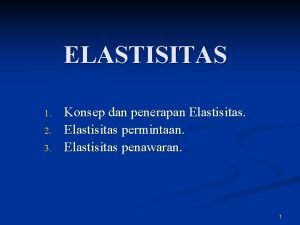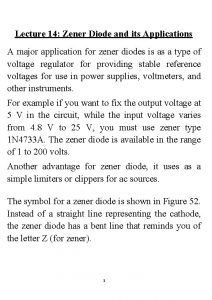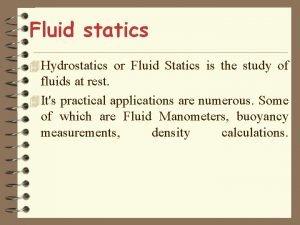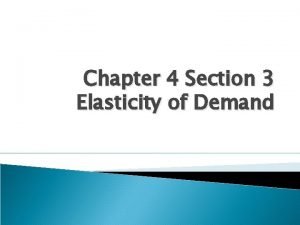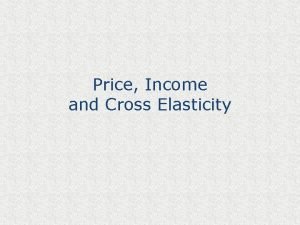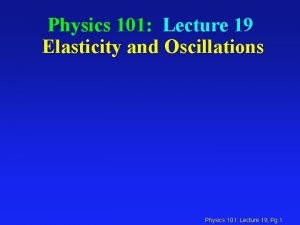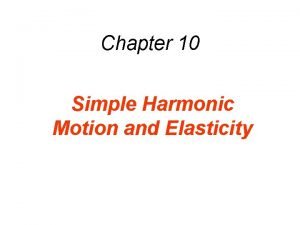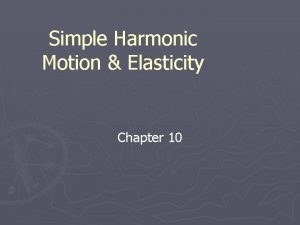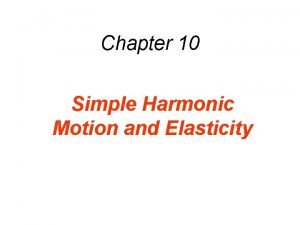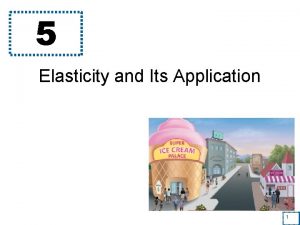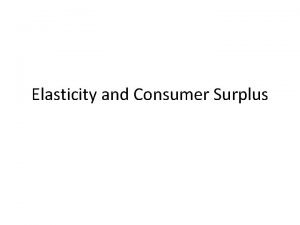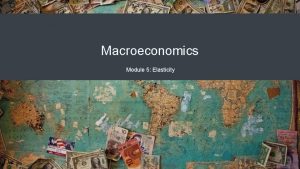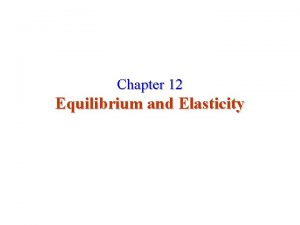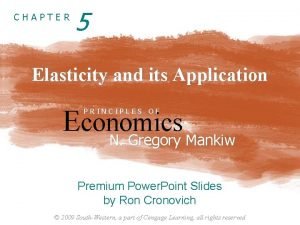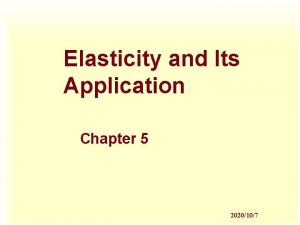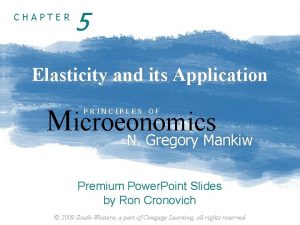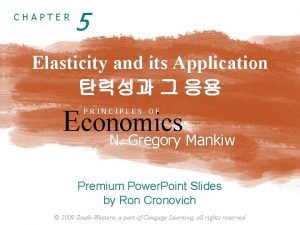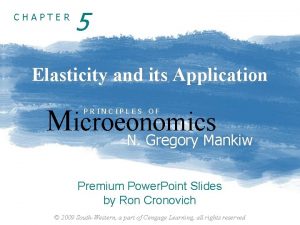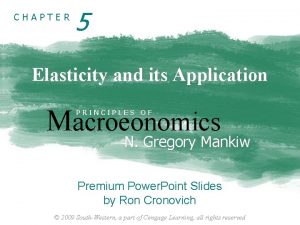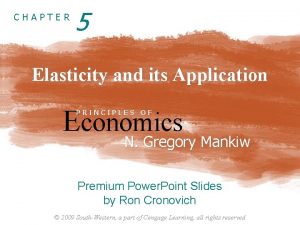Elasticity and Its Application Chapter 5 Elasticity is


























- Slides: 26

Elasticity and Its Application Chapter 5

Elasticity. . . … is a measure of how much buyers and sellers respond to changes in market conditions u … allows us to analyze supply and demand with greater precision. u. Journal Question-Name 3 necessities and 3 luxuries that you would buy. u

Price Elasticity of Demand u Price elasticity of demand is the percentage change in quantity demanded given a percent change in the price. u It is a measure of how much the quantity demanded of a good responds to a change in the price of that good.

Computing the Price Elasticity of Demand The price elasticity of demand is computed as the percentage change in the quantity demanded divided by the percentage change in price. Price Elasticity = Of Demand Percentage Change in Qd Percentage Change in Price

Elasticity, Percentage Change and Slope Because the price elasticity of demand measures how much quantity demanded responds to the price, it is closely related to the slope of the demand curve. But instead of looking at unit change, elasticity looks at percentage change. What do we mean by percentage change?

Brief Assessment on Percentages n n n If there are 50 tomatoes in a store and you picked 16 of them, what percentage of the total did you pick? Paul used to weigh 200 lbs last year, but now he only weighs 175 lbs. How many lbs did he lose? What is the percent change of the loss? What is the average of 300 and 330? What is the midpoint?

Computing the Price Elasticity of Demand Example: If the price of an ice cream cone increases from $2. 00 to $2. 20 and the amount you buy falls from 10 to 8 cones then your elasticity of demand would be calculated as:

Computing the Price Elasticity of Demand Using the Midpoint Formula The midpoint formula is preferable when calculating the price elasticity of demand because it gives the same answer regardless of the direction of the change.

Computing the Price Elasticity of Demand Example: If the price of an ice cream cone increases from $2. 00 to $2. 20 and the amount you buy falls from 10 to 8 cones the your elasticity of demand, using the midpoint formula, would be calculated as:

Ranges of Elasticity Inelastic Demand u Percentage change in price is greater than percentage change in quantity demand. u Price elasticity of demand is less than one. Elastic Demand u Percentage change in quantity demand is greater than percentage change in price. u Price elasticity of demand is greater than one.

Perfectly Inelastic Demand - Elasticity equals 0 Price Demand 1. An $5 increase in price. . . 4 Quantity 100 2. . leaves the quantity demanded unchanged.

Inelastic Demand - Elasticity is less than 1 Price 1. A 25%$5 increase in price. . . 4 Demand Quantity 90 100 2. . leads to a 10% decrease in quantity.

Unit Elastic Demand - Elasticity equals 1 Price 1. A 25%$5 increase in price. . . 4 Demand Quantity 75 100 2. . leads to a 25% decrease in quantity.

Elastic Demand - Elasticity is greater than 1 Price 1. A 25%$ increase 5 in price. . . 4 Demand Quantity 50 100 2. . leads to a 50% decrease in quantity.

Perfectly Elastic Demand - Elasticity equals infinity Price 1. At any price above $4, quantity demanded is zero. Demand $4 2. At exactly $4, consumers will buy any quantity. 3. At a price below $4, quantity demanded is infinite. Quantity

Determinants of Price Elasticity of Demand u Necessities versus Luxuries u Availability of Close Substitutes u Definition of the Market u Time Horizon

Determinants of Price Elasticity of Demand n Demand tends to be more inelastic äIf the good is a necessity. äIf the time period is shorter. äThe smaller the number of close substitutes. äThe more broadly defined the market.

Determinants of Price Elasticity of Demand tends to be more elastic : u if the good is a luxury. u the longer the time period. u the larger the number of close substitutes. u the more narrowly defined the market.

Elasticity and Total Revenue u Total revenue is the amount paid by buyers and received by sellers of a good. u Computed as the price of the good times the quantity sold. TR = P x Q

Elasticity and Total Revenue Price $4 P x Q = $400 (total revenue) P 0 Q Demand 100 Quantit

The Total Revenue Test for Elasticity Increase in Total Revenue Decrease in Total Revenue Increase in Price INELASTIC DEMAND Decrease in Price ELASTIC DEMAND INELASTIC DEMAND

An Example of an Inelastic Good n n n Oil and Oil Prices Insert Economics Video This video will show File 1 and play Arab Oil the supply side issues clip. with getting oil out of the ground. Then the video will focus on the demand (us!) issues of using oil.

Income Elasticity of Demand u Income elasticity of demand measures how much the quantity demanded of a good responds to a change in consumers’ income. u It is computed as the percentage change in the quantity demanded divided by the percentage change in income.

Computing Income Elasticity = of Demand Percentage Change in Quantity Demanded Percentage Change in Income

Income Elasticity - Types of Goods u Normal Goods u. Income Elasticity is positive. u Inferior Goods u. Income Elasticity is negative. u Higher income raises the quantity demanded for normal goods but lowers the quantity demanded for inferior goods.

Cross Price Elasticity of Demand Elasticity measure that looks at the impact a change in the price of one good has on the demand of another good. n % change in demand Q 1/% change in price of Q 2. n Positive-Substitutes n Negative-Complements. n
 Chapter 5 elasticity and its application multiple choice
Chapter 5 elasticity and its application multiple choice Elastisitas silang positif
Elastisitas silang positif What are the 5 determinants of price elasticity of demand
What are the 5 determinants of price elasticity of demand Application of elasticity
Application of elasticity Elasticity
Elasticity Le chatelier's principle and its application
Le chatelier's principle and its application Zener diodes applications
Zener diodes applications Fluid statics equations
Fluid statics equations The emigree poem
The emigree poem Its halloween its halloween the moon is full and bright
Its halloween its halloween the moon is full and bright Section 3 elasticity of demand
Section 3 elasticity of demand Lesson 3 elasticity of demand answer key
Lesson 3 elasticity of demand answer key Chapter 4 section 3 elasticity of demand answer key
Chapter 4 section 3 elasticity of demand answer key When a train increases its velocity, its momentum
When a train increases its velocity, its momentum Cloudy windy rainy sunny
Cloudy windy rainy sunny If its square its a sonnet
If its square its a sonnet Its not easy but its worth it
Its not easy but its worth it Price
Price Elasticity and oscillations
Elasticity and oscillations Price elasticity of demand formula
Price elasticity of demand formula Simple harmonic motion and elasticity
Simple harmonic motion and elasticity Simple harmonic motion and elasticity
Simple harmonic motion and elasticity Oscillation
Oscillation Whats vietnamization
Whats vietnamization Chapter 11 study guide physics
Chapter 11 study guide physics Momentum and its conservation chapter 9
Momentum and its conservation chapter 9 Chapter 12 reconstruction and its effects
Chapter 12 reconstruction and its effects

